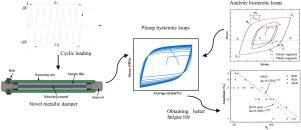Journal of Constructional Steel Research ( IF 4.1 ) Pub Date : 2021-09-01 , DOI: 10.1016/j.jcsr.2021.106911 Yun-Long Zhong 1 , Guo-Qiang Li 1, 2

|
Metallic energy dissipaters with good hysteretic performance and high low-cycle fatigue performance are the ideal devices to absorb seismic energy induced in buildings. Generally, two factors domain the performance of axial yielding energy dissipater, which are the configurations and material it adopts. This paper works on those two factors to develop a high-performance metallic energy dissipater. A novel energy dissipater that uses steel tubes as the buckling restrainer is proposed in this paper, furthermore, the twinning-introduced plasticity (TWIP) steel is used to fabricate the key component of the dissipater, the inner rod, because of its exceptional mechanical property. Experimental tests are conducted on a series of 9 specimens that differ in their geometrical length and loading pattern. Test results indicate that all specimens possess satisfying hysteretic behavior, and the low-cycle fatigue performance of this dissipater is better than that of conventional mild steel made ones. Under compressive load, the inner rod forms helical deformation mode whereas deforms uniformly in longitudinal direction under tensile load, and therefore no necking is observed after tests. Basic mechanical properties including the hardening behavior and compressive strength adjustment behavior are investigated quantitatively. A hysteretic model considering the stress hardening property and frictional forces is developed for this dissipater, and good agreement with experimental data is obtained. Finally, deformation pattern and contact evolution of the inner rod are discussed in detail via numerical model.
中文翻译:

TWIP钢制金属耗能器的概念和滞回行为研究
具有良好滞回性能和高低周疲劳性能的金属耗能器是吸收建筑物地震能量的理想装置。一般来说,轴向屈服耗能器的性能受两个因素影响,即它采用的配置和材料。本文研究这两个因素,以开发高性能金属能量耗散器。本文提出了一种以钢管作为屈曲抑制器的新型能量耗散器,此外,由于其优异的机械性能,采用孪生引入塑性(TWIP)钢制造耗能器的关键部件内杆. 实验测试是在一系列 9 个样本上进行的,这些样本的几何长度和加载模式不同。测试结果表明,所有试件均具有令人满意的滞回性能,该耗散器的低周疲劳性能优于传统低碳钢制造的耗散器。在压缩载荷下,内杆形成螺旋形变形模式,而在拉伸载荷下沿纵向均匀变形,因此测试后没有观察到颈缩。定量研究了包括硬化行为和抗压强度调节行为在内的基本机械性能。针对该耗散器建立了考虑应力硬化特性和摩擦力的滞后模型,与实验数据吻合良好。最后,通过数值模型详细讨论了内杆的变形模式和接触演变。并且该耗散器的低周疲劳性能优于传统的低碳钢制造的耗散器。在压缩载荷下,内杆形成螺旋形变形模式,而在拉伸载荷下沿纵向均匀变形,因此测试后没有观察到颈缩。定量研究了包括硬化行为和抗压强度调节行为在内的基本机械性能。针对该耗散器建立了考虑应力硬化特性和摩擦力的滞后模型,与实验数据吻合良好。最后,通过数值模型详细讨论了内杆的变形模式和接触演变。并且该耗散器的低周疲劳性能优于传统的低碳钢制造的耗散器。在压缩载荷下,内杆形成螺旋形变形模式,而在拉伸载荷下沿纵向均匀变形,因此测试后没有观察到颈缩。定量研究了包括硬化行为和抗压强度调节行为在内的基本机械性能。针对该耗散器建立了考虑应力硬化特性和摩擦力的滞后模型,与实验数据吻合良好。最后,通过数值模型详细讨论了内杆的变形模式和接触演变。内杆在拉伸载荷作用下形成螺旋形变形模式,纵向均匀变形,因此试验后未观察到颈缩现象。定量研究了包括硬化行为和抗压强度调节行为在内的基本机械性能。针对该耗散器建立了考虑应力硬化特性和摩擦力的滞后模型,与实验数据吻合良好。最后,通过数值模型详细讨论了内杆的变形模式和接触演变。内杆在拉伸载荷作用下形成螺旋形变形模式,纵向均匀变形,因此试验后未观察到颈缩现象。定量研究了包括硬化行为和抗压强度调节行为在内的基本机械性能。针对该耗散器建立了考虑应力硬化特性和摩擦力的滞后模型,与实验数据吻合良好。最后,通过数值模型详细讨论了内杆的变形模式和接触演变。定量研究了包括硬化行为和抗压强度调节行为在内的基本机械性能。针对该耗散器建立了考虑应力硬化特性和摩擦力的滞后模型,与实验数据吻合良好。最后,通过数值模型详细讨论了内杆的变形模式和接触演变。定量研究包括硬化行为和抗压强度调节行为在内的基本机械性能。针对该耗散器建立了考虑应力硬化特性和摩擦力的滞后模型,与实验数据吻合良好。最后,通过数值模型详细讨论了内杆的变形模式和接触演变。



























 京公网安备 11010802027423号
京公网安备 11010802027423号